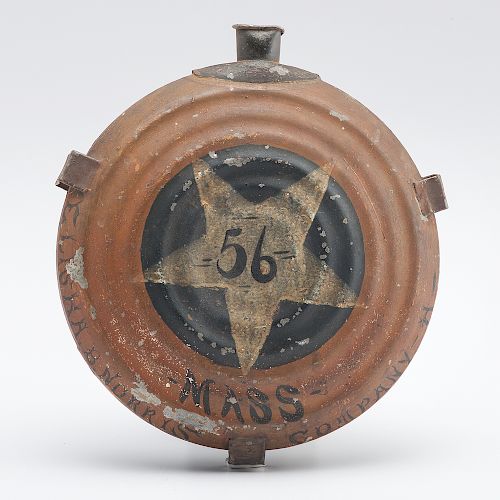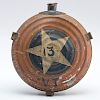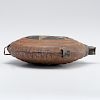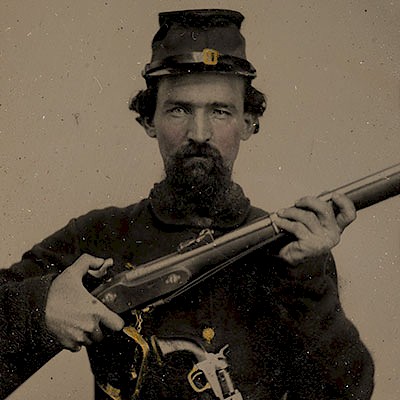Hand-Painted Civil War Canteen Identified to Elisha B. Norris, 13th Vermont & 56th Massachusetts, with Gettysburg History
About Seller
6270 Este Ave.
Cincinnati , OH 45232
United States
With offices in Cincinnati, Cleveland and Denver, Cowan’s holds over 40 auctions each year, with annual sales exceeding $16M. We reach buyers around the globe, and take pride in our reputation for integrity, customer service and great results. A full-service house, Cowan’s Auctions specializes in Am...Read more
Two ways to bid:
- Leave a max absentee bid and the platform will bid on your behalf up to your maximum bid during the live auction.
- Bid live during the auction and your bids will be submitted real-time to the auctioneer.
Bid Increments
| Price | Bid Increment |
|---|---|
| $0 | $25 |
| $500 | $50 |
| $1,000 | $100 |
| $2,000 | $250 |
| $5,000 | $500 |
| $10,000 | $1,000 |
| $20,000 | $2,500 |
| $50,000 | $5,000 |
| $100,000 | $10,000 |
About Auction
Jun 21, 2019
On June 21, Cowan’s Auctions will be offering a remarkable selection of historic photography, letters, documents, flags, political ephemera, and more representing the Revolutionary War-period through the Civil War, Indian Wars, and beyond, as well as the American West. Cowan's Auctions dawnie@cowans.com
- Lot Description
Civil War "Bullseye" canteen, 7.75 in. dia., with three loops for a strap (now missing). Hand-painted brown overall; each side with white star on black circle at center. Obverse star with " 56 " at center and " MASS " below, followed by " Elisha B. Norris, Company H " along lower edge; reverse star with " 13 " at center and " VT " below, followed by " Elisha B. Norris, Company E " on lower edge.
Elisha B. Norris enlisted in the Vermont 13th Infantry as a 36-year-old private in September 1862. The units were formed throughout the summer, and spent many weeks drilling. They were mustered into service October 10 and mustered out in July 1863 at Brattleboro, VT. According to the canteen, Norris was mustered into Company E. (Some records show him in other companies.) Although composed of about half farmers, there were more than enough college students and graduates to fill the officers' positions in the unit, and a few were particularly talented military men. The regiment left for Washington on October 11th, arriving on the 13th and followed shortly thereafter by the 14th, 15th and 16th, with the 12th having preceded them. By the 27th they formed the Second Vermont Brigade.
They marched up Arlington Heights, then on to the heights south of Alexandria, along with the other regiments forming "Camp Vermont." They spent another month on picket, fatigue, drills, etc. until the end of November when the 13th, 14th & 15th were sent to Fairfax Court House, thence to Union Mills. They formed a picket line along Bull Run, but when there was no rebel encounter, and additional troops arrived, they returned to Camp Vermont. Two weeks later they returned to Fairfax Court House, remaining for over a month supporting the picket line at Bull Run. On December 27, they were lined up for battle, as outlying pickets had reported Stuart's cavalry approaching the village. There eventually was a brief skirmish, but General Stuart moved on after the artillery began firing. The 13th VT tried to intercept him, but was unsuccessful, returning to camp the following morning.
Near the end of January, the 12th, 13th and 14th set up camp in the vicinity of Wolf Run Shoals and a few miles downstream. A wagon train returning to Fairfax Station for supplies was attacked by a group of Mosby's men. They were taken 27 miles away along with mules, then allowed to return on foot. In late June, they could hear the cannons at Chancellorsville, but did not receive orders to join. Several days later they joined Hooker's army on their seven-day march north to Gettysburg.
They arrived at Gettysburg on the evening of July 1 and took a position to Buford's left, guarding the left of the army. The next morning, they supported the batteries on Cemetery Hill, where it was occasionally subjected to shells fired from three different directions, converging on their position. They could see the action on Little Round Top, the Wheat Field, the Peach Orchard and Emmettsburg Road from their position. They then shifted to guard a battery on the west face of Cemetery Hill where five companies remained until night. Other companies of the 13th went to Hancock's aid after he and Sickles had been driven back from Emmettsburg Road. In the meantime, others of the "Vermont Brigade" under Colonel Randall went to recover a battery. His men charged down the descent up which Pickett's men would charge the following day. They recovered the guns to the cheers of Hancock's men, then set off in pursuit of the enemy. They took eighty-three prisoners, including one man who lay among the dead as if he was also, only to rise up and shoot at passing Union soldiers. Company E was among those with Randall who executed these daring dashes.
The following day, a detail of men set up a line of fence rails near where the men had slept on the field. As Pickett's charge was underway, the 13th Vermont took up positions behind these rails. Initially they were told to hold fire, but when the 16th Vermont, deployed as skirmishers, fell back through the lines of the 13th, the latter brigade was finally ordered to fire. They severely damaged the rebel lines, then shifted slightly to the right, firing as soon as they reached the new position. General Alexander Hays' brigade then opened fire on the left of Pickett's men, and in very short order they threw down their weapons and surrendered. They took 243 officers and men.
On July 6th, the 13th set off in pursuit of the retreating rebels. A few days later, they were ordered home, their term of service having expired. After review and thanks by the Governor at the Battleboro barracks, they were mustered out on July 21. Many of the men seem to have subsequently enlisted in other units.
Elisha Norris (re)enlisted in January 1864 in the 56th Massachusetts Infantry, Co. H. This was the first Veteran regiment which began recruiting in late 1863. Men enlisting in the 56th had to have at least 9 months prior service. Various companies were mustered in from just after Christmas through Feb. 1964. The 56th left the state in late March for Virginia. It was engaged in the Wilderness campaign, Spottsylvania, North Anna River, Cold Harbor and Bethesda Church. It then moved to Petersburg and was still there for the "Crater" fight. It participated at Weldon Railroad, Poplar Grove Church and more. It was sent to Fort Davis (Jerusalem Plank Road) then Fort Alexander Hays for the winter. They participated in the final assault on Petersburg in the spring. After Lee's surrender, they were sent to Alexandria and mustered out July 12.
An exceptional canteen memorializing Elisha B. Norris' Civil War service.One dent near the top of "13." A few areas where paint has worn/flaked off.Condition
- Shipping Info
-
Buyers are required to pay for all packing, shipping and insurance charges. Overseas duty charges are the responsibility of the successful Bidder. Be aware that for larger and/or valuable items, shipping charges can be substantial. - If there is no shipping amount on listed your invoice, you will need to make arrangements to pick up or ship your purchase through an alternative shipping company. Our shipping department can be contacted at 513.871.1670 (ext. 219) or email shipping@cowans.com. - Shipping charges include insurance for your order while in transit. If you have private insurance we will adjust your charge to include only packing and shipping. - Please allow 14 – 21 days after payment to package and ship your purchase as carefully as possible.
-
- Buyer's Premium



 EUR
EUR CAD
CAD AUD
AUD GBP
GBP MXN
MXN HKD
HKD CNY
CNY MYR
MYR SEK
SEK SGD
SGD CHF
CHF THB
THB













